
You are the mayor of a town on the island of Machi Koro. Life's pretty laid back: You usually roll into work a few hours late, shake some hands, grab lunch, maybe take a nap, then head home. It's a good job. Super low pressure.
One day, a mayor on the other side of the island decided to build some new establishments. The citizens started visiting these establishments, and talking about establishments, and talking about building more establishments. Things got competitive, and suddenly you had to work at your job.
Now all of the mayors are trying to outbuild each other in order to be named the best mayor on the island. As if that weren't enough, you have all
Components
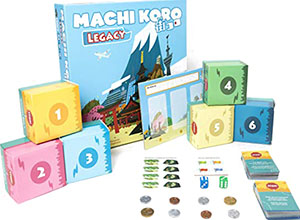
- 1 Legacy Deck
- 8 Town Square Cards
- 12 Landmarks
- 1 Community Landmark
- 40 Establishments
- 4 Reference Cards
- 4 Town Boards
- 6 Mystery Boxes
- 8 Stickers
- 4 Flag Tokens
- 2 Oversized Dice
- 78 Coins
Card Anatomy
Establishments
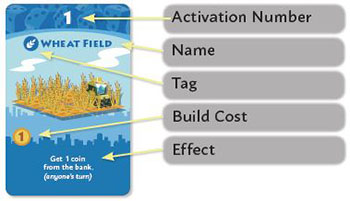
Landmarks
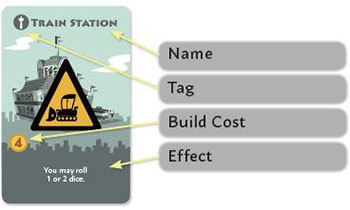
Community Landmarks
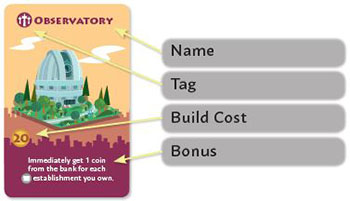
What is a Legacy Game?
Legacy games are games that grow and change over time, often as the result of player choices. In Machi Koro Legacy, you play through a campaign that lasts for ten games. As you play, you will find new components, learn new rules, and discover an unfolding narrative.
The goal is for your group to participate in telling the story of Machi Koro, a fantastic island where wonderful things can happen. In each individual game of the campaign, the goal is to win, and the winner gets to inscribe their name in the town register.
The campaign holds many surprises, so follow the golden rule: Do not open or reveal anything until you are instructed to!
This applies both to the secret compartments in the game box and to the cards within the legacy deck.
There will be something new revealed after just about every game in the campaign. Sometimes you will be asked to learn a new rule. When this happens, you will be given a card explaining the new rule, which can be referenced at any time.
Between games, everything resets, as though you put the game away and then pulled it back out to play again -though you can play multiple games in a single session! But, as you discover new rules and components, things won't quite start the same every time.
If you have played Machi Koro before, that's okay. You'll be familiar with certain elements, but you'll find that many things here are different from what you remember, and you'll discover new and exciting things as the campaign unfolds!
Important Concepts
The Legacy Deck
The legacy deck is intended to be read one card at a time, in order, beginning with the top card of the deck. Read the A side first, then the B side. Never read a card out of order!
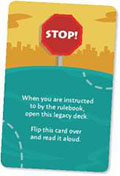
When you are instructed to read a card in the legacy deck, keep drawing and reading cards from the legacy deck, one at a time, until you come to a card that says stop.
When you do, stop immediately. The card where you stopped will have instructions for when to flip the card over and keep reading.
If the legacy deck ever gets out of order, ask someone who is not part of your campaign to put them back in order, using the legacy deck numbers in the bottom right corners of the cards.
The Mystery Boxes
Certain cards in the legacy deck will tell you to open a specific mystery box. When this happens, immediately stop reading in order to open that box and reveal the contents. Then continue reading cards to find out what to do with the new things you've discovered.
The Rules Deck
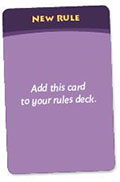
As you play through the campaign, new rules will be introduced. When this happens, you will receive a rules card from the legacy deck, which will explain and illustrate the new rule. Keep all of these rules cards together in a single deck.
At the start of each game, remove the rules deck from the reserves and place it nearby. While playing, refer to the cards in the rules deck to make sure you are playing correctly, since those new rules will not be listed within this rules.
Each player starts with a reference card that explains the turn sequence. As new rules are introduced that add new steps to the turn sequence, each player will receive a new reference card from the legacy deck.
When this happens, destroy the old reference card; it will never be used again, not even in free play after the campaign is over.
The Reserves
During the campaign, sometimes you will be instructed to put cards or other components in the reserves. Things in the reserves are not being used during the current game, but might come back into play in future games.
In the game insert, there is a well that is divided into two slots. Choose one of these slots to function as the reserves. When instructed to put something in the reserves, place it in this slot.
The Archives
During the campaign, sometimes you will be instructed to put cards or other components in the archives. Things in the
archives will not be used again for the rest of the campaign. Do not destroy things in the archives, however, as they might be used again in free play after the campaign is over.
In the game insert, there is a well that is divided into two slots. x Choose one of these slots to function as the archives. When instructed to put something in the archives, place it in this slot.
Before The Campaign
When you get to this section, immediately open the legacy deck and read the first card, which will instruct you to take the 65 starting cards from the legacy deck. It is important for you to have access to these starting cards as you learn how to play the game.
You can easily recognize the starting cards because they are unnumbered, with a star in the lower right corner where the legacy deck number would normally be.
After you take the starting cards from the legacy deck, you will come to a card that says stop. Do not read any more cards from the legacy deck until you have finished reading these rules and are ready to play the first game of the campaign.
Note: Exact cards shown may not appear in the game. These cards are used as spoiler-free example.
Start of The Game
When you are ready to play each game, the legacy deck will instruct you to flip the next card in the legacy deck and read it aloud, which will reveal more of the unfolding story. Then carry out the following steps to prepare for the game:
-
Sort the establishments into face-up stacks by type.
Then place these stacks in the center of the play area as the supply. These stacks should be arranged in numerical order, from left to right, according to their activation numbers.
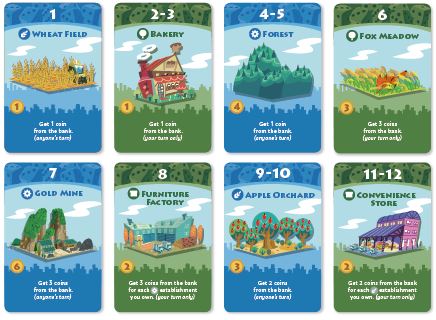
In the first game, the first stack will be Wheat Fields
1and the last stack will be Convenience Stores (11-12). In future games, if there are multiple establishments with the same activation number, those stacks can be arranged in any order. -
Give each player the town board and flag token in their chosen color. Then give each player an identical set of three landmarks, which they should place in the slots on their town board, face down.
These landmarks should be arranged in alphabetical order, from left to right, according to their alphabetical identifiers.
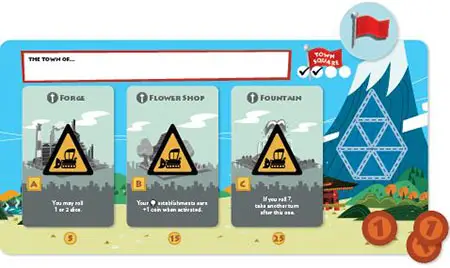
In the first game, the three landmarks are the Forge
A, Flower ShopB, and FountainC. In future games, each player will have two landmarks from the previous game and one new landmark received from the legacy deck during setup. -
Place the community landmark near the supply, face up, so that all players can see it.

In the first game, the community landmark is the Observatory. In future games, you will receive a new community landmark from the legacy deck during setup.
-
Give each player the set of town square cards with backs matching their chosen color. Each player privately chooses a number of these cards equal to the number of check marks on their town board, then reveals and adds them to their town.
These cards should be arranged in numerical order, from left to right, according to their activation numbers. Return all unchosen town square cards to the reserves.
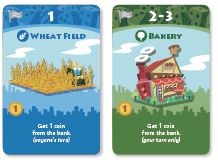
In the first game, there are only two town square cards for each player: the Wheat Field and the Bakery. In future games, players will have more town square cards available and will be able to choose which cards to start with.
-
Place all of the coins off to one side, within reach of all players, as the bank. Then give each player three coins from the bank.

In future games, there may be additional steps for you to perform right now; simply carry out any "at the start of the game" instructions listed on the cards in your rules deck.
Game Play
In each game, your goal is to build all three of your landmarks and contribute to the community landmark. If you are the first player to do so, you win!
In the first game, determine the first player by having each player roll two dice; the player who rolls the highest number is the first player. In all future games, the player who won the previous game is the first player.
Players take turns in clockwise order.
Each turn has three steps:
- Roll Dice
- Activate Establishments
- Take One Action
1. Roll Pice

In this step, you roll the dice once. At the start of the first game, you will only roll a single die.
But, once you have built your Forge, you may roll one or two dice each turn (your choice). If you roll two dice, add their rolled numbers together to get the result.
2. Activate Establishments
In this step, all players (not just you!) can earn income from their establishments, based on the result of the dice roll.
Each establishment has an activation number. When the result of the dice roll is equal to an establishment's activation number, that establishment activates.

Establishment Types
There are four different types of establishments that you will encounter throughout the campaign, which activate in different ways:
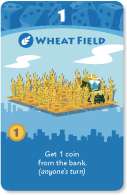 Blue |
Activates on anyone's turn.
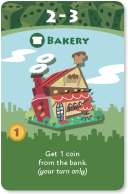 Green |
Activates on your turn only.
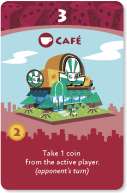 Red |
Activates on opponent's turns.
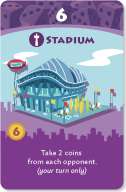 Purple |
Activates on your turn only.
Establishment Tags
Each establishment has a tag, indicated by the icon next to the card name. The effects of some cards reference these tags. When a card effect refers to a specific tag, count the number of establishments with that tag that you own, including duplicate copies.
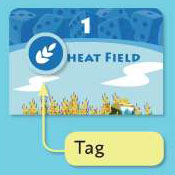
Note: Occasionally, a card effect refers to a specific tag but asks you to only count unique establishments with that tag.
In that case, only count each establishment with that tag once, ignoring any duplicate copies you own.
Activation Order
It is possible that multiple types of establishments are activated by the same dice roll. When this happens, establishments activate in the following order: Red > Blue and Green > Purple.
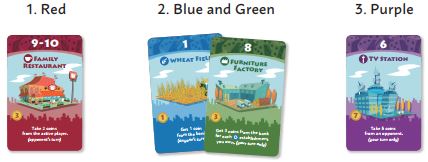
Note: If you have multiple copies of a single establishment, each copy activates separately when that establishment's activation number is rolled.
-
Transactions Between Players
If you owe coins to an opponent, but do not have enough to pay it all, you must pay what you can, then the remaining deficit is ignored. The player who you owed coins to does NOT receive coins from the bank to make up the difference.
Remember to follow the proper order for activating establishments! Because red cards activate first, if you owe coins to an opponent (because of their red cards), that payment is made before you earn income from your other establishments.
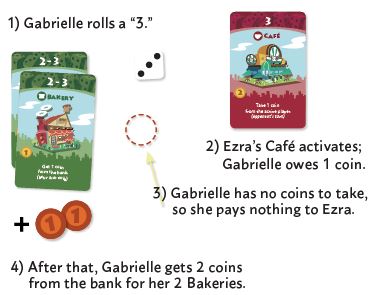
-
Multiple Transactions
If you owe coins to multiple opponents at the same time, those payments are made in reverse turn order (i.e., counter-clockwise). Pay each opponent what you owe them, in full, before you pay the next opponent.
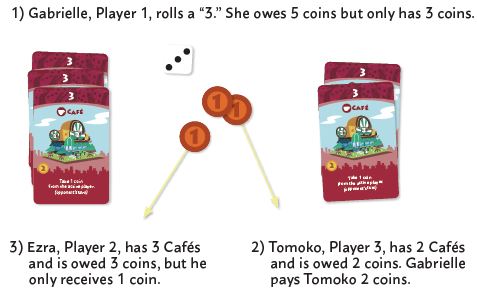
3. Take One Action
In this step, you may -but are not required to-take one of the available actions:
- Build an Establishment
- Build a Landmark
- Contribute to the Community
Note: Throughout the course of the campaign, there may be other actions that become available. (You'll get a new reference card to help you remember). Just remember that you can only take one action each turn!
A. Build an Establishment
To build an establishment, spend coins equal to the build cost shown on that establishment card. When you do, take that card from its stack in the supply and add it to your town. It can now be activated on future turns.
If you own multiple copies of a single establishment, keep them in a single stack, splayed vertically so that you can easily tell how many copies you own.
As you add new cards to your town, place them so that the cards in your town stay in numerical order, from left to right, according to their activation numbers.
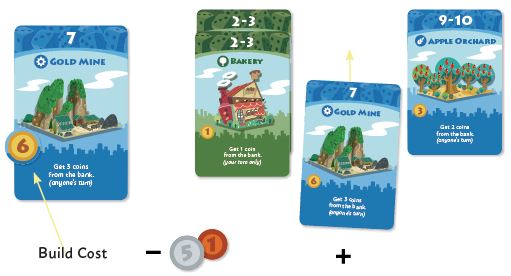
B. Build a Landmark
To build a landmark, spend coins equal to the build cost shown beneath that landmark's slot on your town board. When you do, flip that landmark card face up. Once you have built a landmark, its effect applies to all future turns.
You are not required to build your landmarks in alphabetical order; you may build your landmarks in any order, but you must build all three to win.
C. Contribute to the Community
To contribute to the community, spend coins equal to the build cost shown on the community landmark card in play for this game.
When you do, place your flag token on the community landmark card to indicate that you have made your contribution, then gain the bonus listed on the card.
You are not required to build all of your landmarks before you contribute to the community landmark; you may contribute at any time, but only once per game.
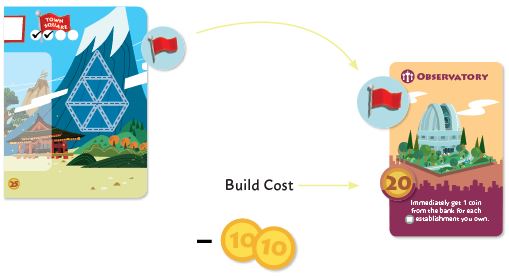
Continue Reading


